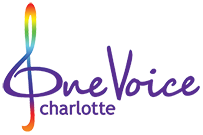June/July | When you’re doing perspective interviews about the LGBTQ community, it certainly helps to include someone with a historical view. That makes LGBTQ archivist and historian Joshua Burford a prime subject. And with this month’s opening of the exhibit he assembled for The Levine Museum of the New South—“LGBTQ Perspectives on Equality”—the timing couldn’t be better.
Burford teaches a two-part unit on LGBTQ history for UNC Charlotte where he is Assistant Director for Sexual and Gender Diversity. He is one of very few people teaching LGBTQ history in the U.S. He has degrees in history and library science. He also has a passion for helping the LGBTQ community know and embrace its radical roots.
A Community Born. A Generation Lost.
Burford has said that the LGBTQ community in the U.S. knows less about its own history than most other minority cultures. Why is that? He cites two major contributing factors. First, there’s the tendency of the dominant culture to marginalize the history of minority cultures. But Burford also shares that, “LGBTQ people spent the first 70 years of the last century just trying to have a community.”
He explains that in the 50s, small groups of gays and lesbians started talking about openness and liberation. But it took until the 70s for LGBT people to really start to unite and see themselves as a community that deserved rights. Says Burford, “We went from being isolated pockets of people to thinking of ourselves as a national community. And we immediately adopted the language of the civil rights movement.” The term “gay pride” was born, and gay pride marches were a form of radical protest as well as celebration.
Then came AIDS. Burford shares, “We spent the 70s being excited to be around each other, but then from 1978 well into the 80s, gay men were dying quicker than we could do anything about. Because of that, there’s this this huge gap in our community memory.” And that’s not all that was lost.
Explains Burford, “AIDS—devastating in so many ways—also hit us at the absolute worst time for the [gay pride] movement. We were getting to the place where we were organizing ourselves in a very specific way.” Then many of the movement’s leaders were lost, and dealing with the health crisis understandably dominated the focus of the community’s energy for close to the next decade of the epidemic.
From Liberation to Inclusion
According to Burford, the people who survived that period to become leaders—primarily those with more resources–shifted the movement in a more conservative direction. He shares, “We had been a community of radicals, demonstrating against the establishment. Then, aiming instead for political inclusion and protection of property, we began to adopt more of a ‘we’re like you’ approach.”
Says Burford, “Historically, there’s this large disconnect from the early part of the movement and where we are today.” He cites a 90’s New York City pride parade as an example.
“On one of the big anniversaries of the Stonewall Riot,” he says, “parade organizers wanted to have a history float and bring back some of the people who were there. But Sylvia Rivera—often credited with throwing the first punch at Stonewall—was kept off the float [because] she was also a radical trans activist and former sex worker who had done things that made them uncomfortable. They decided her presence would be too distracting.”
Says Burford, “Without the contextualization of our earlier history, we’re left to keep reproducing a narrative that’s fed back to us through our own marketing channels.” Over time, Burford sees this as having led to an LGBTQ movement that is increasingly focused on one issue: marriage equality. He says, “The message is that if you can enshrine your relationship within the largest, single, defining cultural definition that exists, then you’re no longer an outsider.”
Burford, himself, takes issue with this message because of the number of LGBTQ people whose lives will change very little if same-sex marriage becomes legal throughout the U.S. He explains, “Marriage equality doesn’t really help the poor gay kid trying to get by. It doesn’t advance the transgender community or transgender health, LGBTQ homeless youth, LGBTQ history in schools, employment nondiscrimination. The list goes on.”
History as Tool and Fuel
Ultimately though, Burford’s knowledge of history moves him to call attention to what he sees as a bigger-picture risk of disconnecting from our radical history.
Shares Burford, “The political strategy of ‘we’re just like you’ hasn’t worked for any minority community as a whole.” He explains that making deep change has required staking ground for a community as it is, with all its differences. Burford’s personal beliefs, shaped by the history he knows, go even further. “I reject the notion of equality as a political stand because I don’t want to equate to a politic that has spent so much time oppressing us. Instead, I want to liberate us from the systems of cissexism, misogyny and homophobia that have plagued us since our founding.”
How does history play a part? Says Burford, “There’s empowerment in knowing the history of activism and art in our own community.” He cites Charlotte’s own pioneers, like Tonda Taylor who endured great adversity to bring a then-radical concept like Time Out Youth to life. Now Time Out Youth is the definitive lifeline for hundreds LGBTQ youth in the region. Examples like that both validate and embolden.
“History is powerful. People think of it as looking backward, but history can be the fuel to propel us forward.”
Interested in more perspective? Read our InSight Interview with Jenni Gaisbaurer, Chair of the Charlotte Lesbian and Gay Fund.
The “LGBTQ Perspectives on Equality” exhibit runs from July 25 to Jan 25 at the Levine Museum of the New South (200 E. 7th Street, Charlotte, NC).


